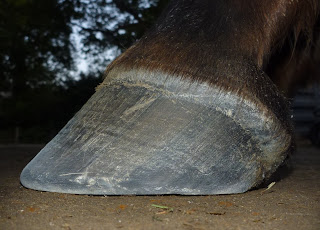Especially not on her blog. Sorry.
I'll have had her for 3 years in July and she is an example of how horses/hooves can have a roller coaster ride, but still generally improve over time. And many changes, both good and bad can be reversed.
Slightly gobsmacked that she is doing pretty well hoof wise despite laminitis rearing its head all around and despite a lack of work. Although of course she could tip over the edge tomorrow. Spring last year she didn't do so well. This year the Spring grass is worse and going on for much longer, but she is foot wise suffering less.
Guts though are terrible with the sheer quantity of long, very wet, low fibre, high sugar, low mineral grass. Edible charcoal and Yea Sacc are helping me out. I keep her in for the occasional whole day too, just to dry her tummy up. Ideally I'd like her brought in at noon and for a while this worked really well, but there are 'technical' issues so this is what we are doing for now.
 |
I'd like better concavity but not too bad. Nov 2011 and
below
|
 |
Slightly longer toe than I'd like but okish for a pasture pet
|
Grace reinforces the notion that a lot of hoof troubles start in the hind gut. I work my butt off/spend a fair bit to try and help her out with this and so far it seems to be paying off. Still cheaper than shoes. But of course this is not why she is barefoot which is entirely for her sake.
I can better identify any onset of laminitis and take remedial action. Grace can develop and use her caudal hoof, essential for protecting her limbs from concussion (oh boy do I hate riding shod horses after years of bare). Also an essential element of preventing navicular syndrome.
While barefoot doesn't entirely prevent thrush (far from it) it is easier to treat and bare horses that are mineral balanced, healthy and in work seem to suffer much less.
Grip on roads is great and with correct conditioning, again especially of the caudal foot, they slip over most surfaces much less.
Some bare horses seem to slip more on short wet grass, some less. I can't judge that one as the feedback from clients is mixed. I do think that unbalanced riders can bring a bare horse down more easily on wet grass.
But the shod horse is staying upright at the expense of long term joint/ligament health - so if you are not balanced my advice is 'Don't jump short wet grass - period'.
I know at the time it is hard, yes I was once a teenager, despite my Mum saying I was born aged 40....... but there are more important things in life than ribbons.























